The Palindrome Experiment
Words and Photos by Rachel Simmons
I remember the first time I heard the word palindrome. I was in the 4th grade, and I thought it was awesome. I mean, could “straw warts” really read the same backward as it does forward? The answer is yes. And that makes me happy in a strange inner region of my brain. It makes me outwardly happy, too. Just say it out loud – “straw warts.” I bet you’re smiling now.
What does this have to do with spinning? On the surface, nothing. However, when you combine spinning with the goal of making cloth, you can create a palindrome warp for weaving. At least that was my goal in this experiment of wooliness. I am not sure if you’ve ever experienced the disappointment of the chaos that can come from randomly warping a multi-color yarn, but this technique avoids the weird mud through careful measurement. Many handpainted skeins of yarn have repeats, which means that if you can measure out the repeat, you can use it to create vertical color pooling in your warp.

This simply means, as long as you’ve measured correctly, the colors out to your warping peg turn back on themselves as you head back to your loom. (This would also apply to the down and back journeys on a warping board.) By taking advantage of a hidden symmetry, you can preserve the beautiful painterly effect of your handpainted yarn in the cloth you create. An excellent resource on creating cloth with palindrome skeins is from Syne Mitchell, in both her book Inventive Weaving on a Little Loom as well as her article on Weavezine.[1]
It is not hard to find a skein of yarn at your local yarn shop that can be used for a palindrome warp. Many (not all) hand-dyed yarns naturally have this repeat because of the way they are dyed. The real question was if I could create a palindrome skein of yarn by spinning a painted braid of fiber. My belief was that I could create this wonderful, mysterious color repeat through spinning in order to create a cloth with vertical color pooling that preserved a hand-dyed fiber’s beauty. I will state right up front that I was somewhat successful in this first attempt, but a first attempt was never expected to yield perfect results, right? I did learn a lot from this experience and have a lot of new ideas for future directions, as well as a very pretty skein of yarn.
My thought was that I could ensure a palindrome repeat by taking a braid of fiber and spinning it down the side from end A to end B and then flipping the braid to continue spinning from end B to end A. This would create a colorway that could fold back on itself. I am sure someone much cleverer than I has already given this technique of spinning a name, but I will call it the back and forth string cheese method. Using my Ladybug, on a 6.5:1 medium speed whorl, I got to work. The fiber I used was the repeating colorway Southdown by Hilltop Cloud.
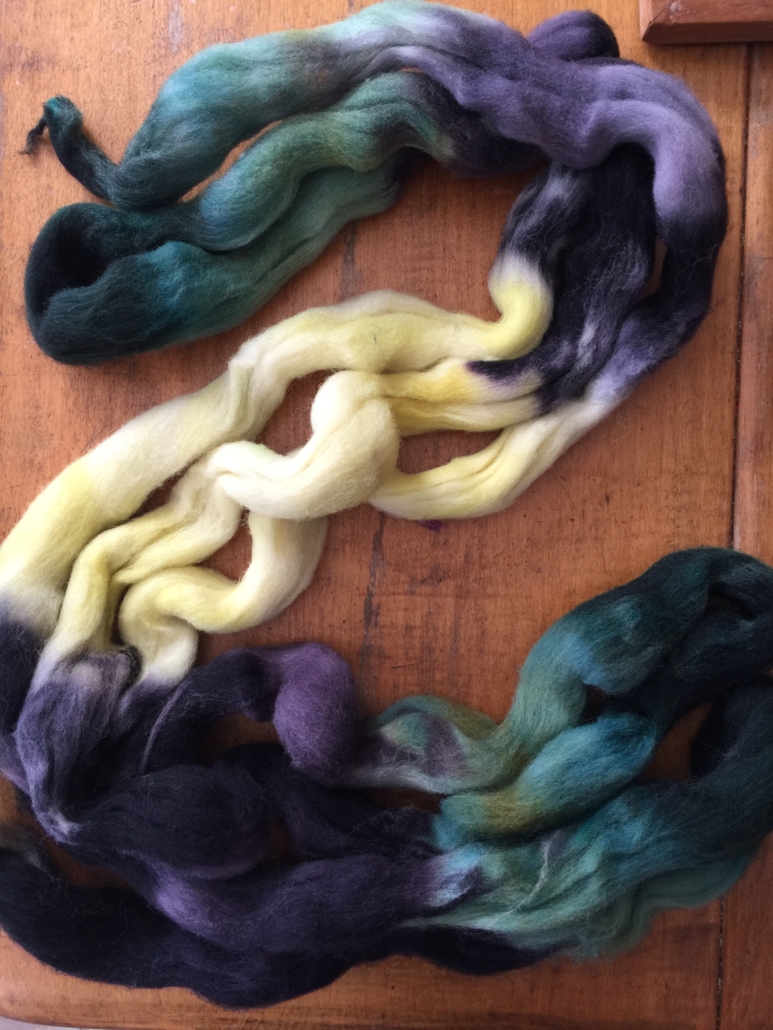
A lot worked with this idea, but a lot didn’t work, too. First, it was a little cumbersome trying to manage the length of an entire 4 oz. braid as I spun. The length never shortened, either, because I never spun across the fiber, only down the side. In addition, this length created a really long repeat. I tried cheating by thinking a repeating colorway in the braid itself would shorten my repeats, but this did not actually help due to the variability in color group sizes. For example, the yellow color at the top of the fiber was much smaller than the one in the middle, and thus essentially was its own color group that could not be matched with a middle yellow. However, it is a lovely visual of how a colorway can turn back on itself. In future efforts, if I try this string cheese method again, I will have to considerably shorten the length of fiber I am using in order to shorten my repeat length.
I spun the fiber as a single that I then chain plied.
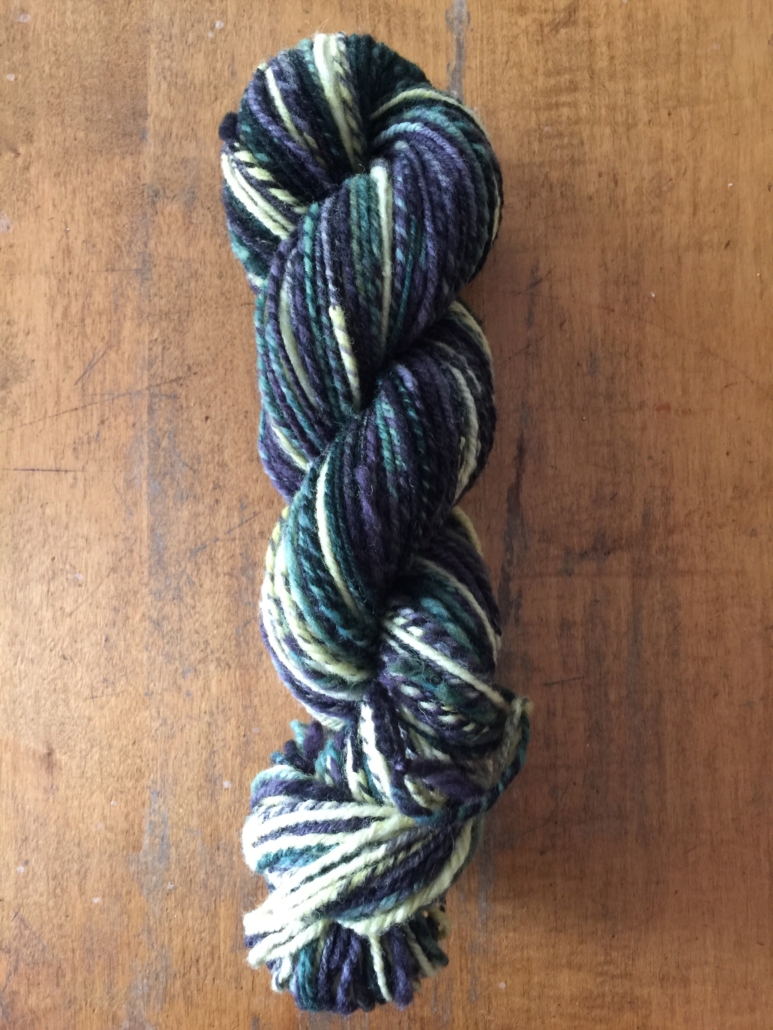
This, too, presented some issues. I introduced too much variability. First, there was the variability in spinning the single. For example, perhaps I lingered in one spot too long and altered the length of a color group. The color runs were a little short to take full advantage of chain plying, too. This yielded unwanted barbershop poling within my skein. I could not create exactly the same size loop on every ply, so this also affected the length of the color runs. In future attempts, a 2-ply yarn may give me more control over which colors land where, making the overall effect of the yarn more successful. I am also considering singles yarn – perhaps a better place to start though a trickier beast to warp. However, using a rigid heddle loom is fairly forgiving with yarn abrasion and I could try sizing the singles yarn prior to warping for added strength.
As a proof of concept, I warped a small section of yarn on a 10-inch SampleIt rigid heddle loom. The yarn itself was a worsted weight at 10 WPI, and I used a 7.5-dent reed. I warped 30 ends and wove a plain weave pattern. This is where the length of my repeat in the yarn became a little unruly. Ideally, a repeat should happen in a normal skein that can be wound in a 1.5–2 meter loop. The repeat would then be on the scale of inches. My repeat was on the scale of feet. My yarn could fold back on itself at 13 feet. That’s a little long. However, this proof of concept trudged ahead regardless of its lankiness. To see the whole sample, I had to use my front steps of my house.
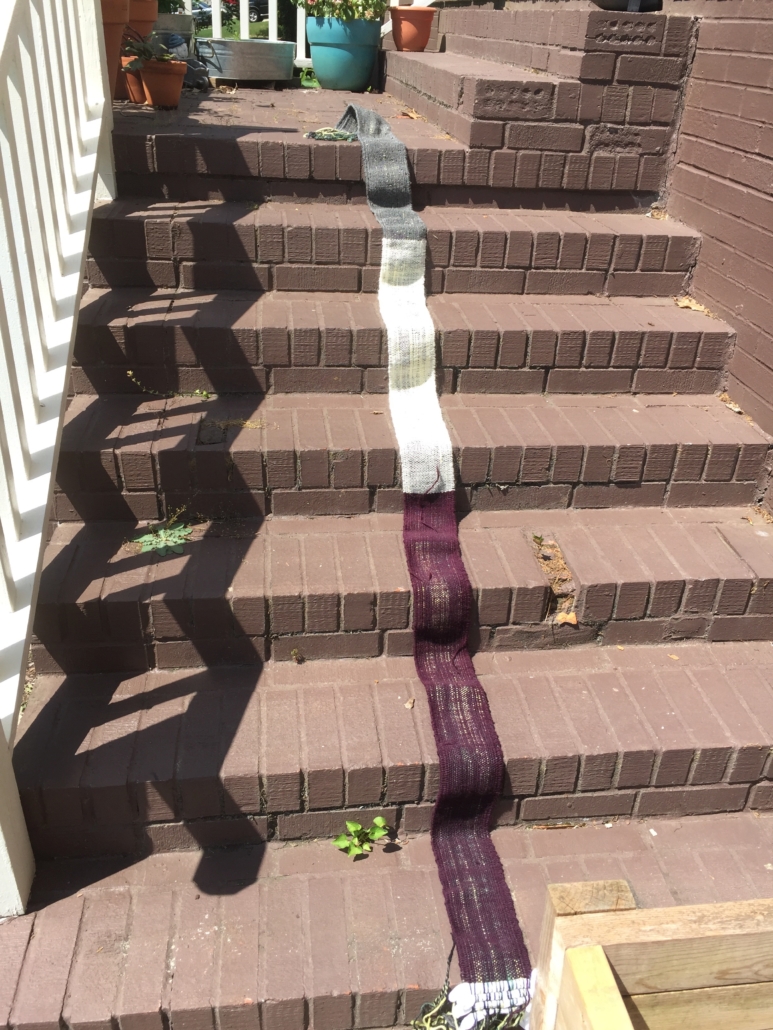
I was able to match general color groupings. The color pooling was not as clean as I would like, but the cloth has distinct areas of color dominance. In the warp, the shift from the darker colors to the yellow was the most obvious vertical color pooling. I sampled with both a dark and light and medium tone weft to experiment how to create the cloth to make the warp threads visually come forward or recede back. I wove the weft at approximately 11 picks per inch for each of the 3 colors. The dark weft allowed the colors to show stronger than the light weft, but the light weft did show the yellow quite well. The medium tone hid the warp colors almost completely and would not be a good choice for a palindrome final project/spin, though it did create a pretty cloth in its own right.
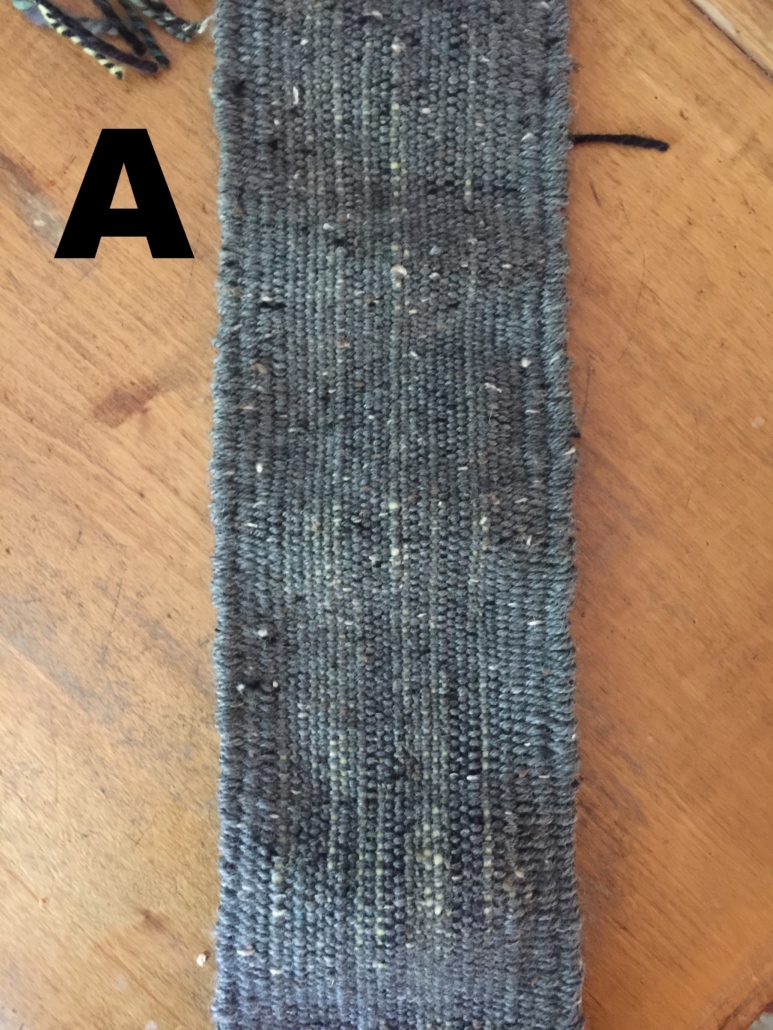
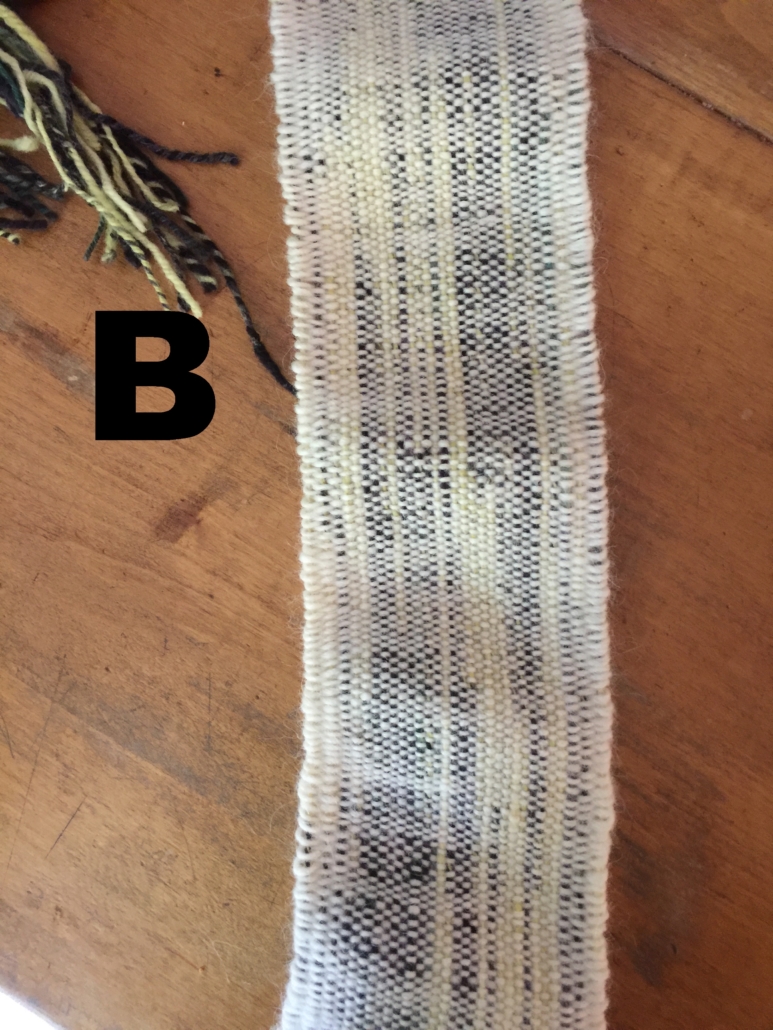
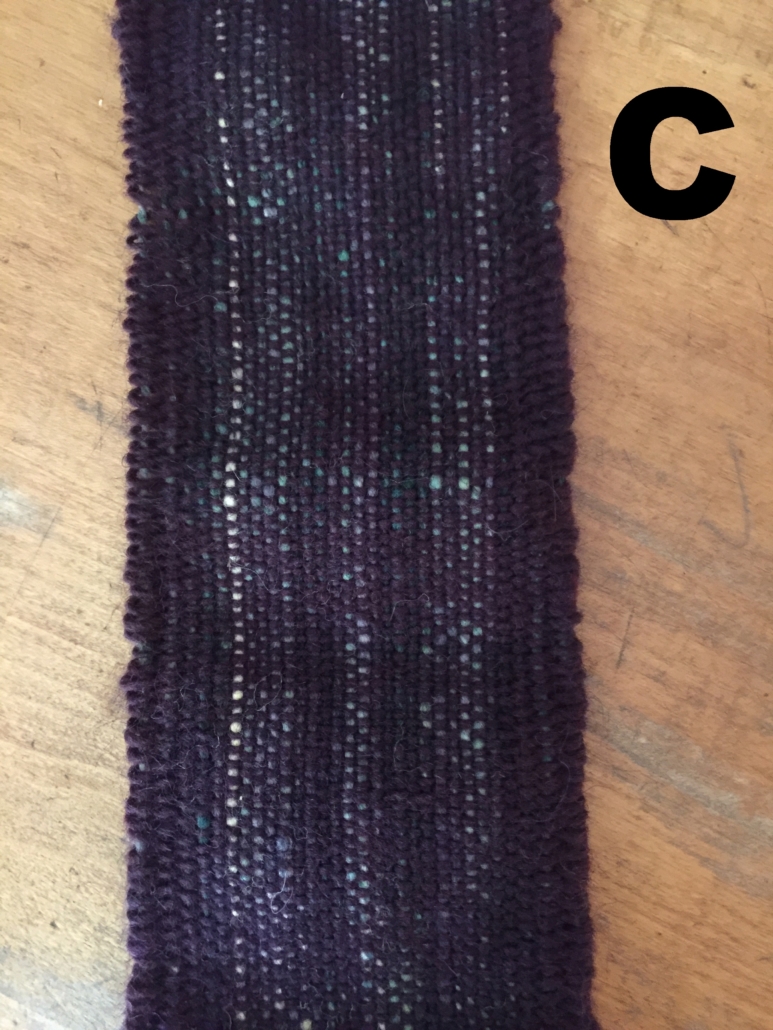
The end goal, of course, was a beautiful cloth. This little sample I created had its own beauty, and more importantly, it made me even more excited to achieve my palindrome dreams. It is close but not quite what I wanted in my cloth, nor did it allow me the freedom that a better executed skein would allow. While this is the end of the first attempt, I will continue to try (and document) my efforts to create my own form of “straw warts” through spinning.
Rachel Simmons lives in Huntsville, Alabama with her 3 small boys and her very patient husband. She loves all things fiber, most things chocolate, and some things pink. She maintains her own modest fiber blog at http://www.yarntyouglad.com.
[1] https://www.weavezine.com/spring2008/wz_sp08_SyneMitchell.php.html


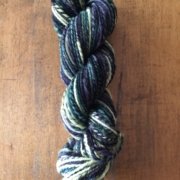


Leave a Reply
Want to join the discussion?Feel free to contribute!